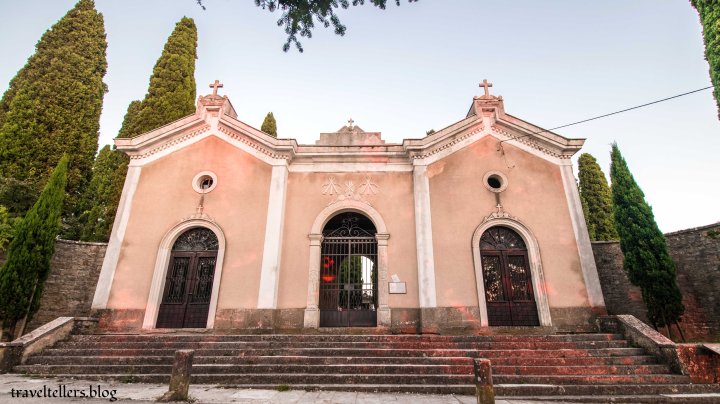If we ever make a list of our top five towns or cities in Croatia then Grožnjan would certainly find a place in it. This little medieval town simply charmed its way into our hearts. In fact, after visiting the town we have started believing that when the adjective ‘charming’ was coined for the hilltop towns of Istria, it must have been done keeping Grožnjan in mind. The town, which has kept its medieval urban core almost intact, exudes charm from every alley, every square and every building. Now, if we talk about ‘places to see in Grožnjan’, there is next to nothing, but this is a town whose every nook and cranny deserves to be explored. Hence, Grožnjan is not a town which can simply be visited. One has to experience it by living in its hundreds of years old stone houses, by walking its cobblestone alleys decorated beautifully with flowers and vines, by marvelling at the breathtaking lush green landscape that encompasses it, by enjoying the serene sunsets standing at its one end, and by roaming around it after dark when it is awash with a yellow glow of the lamps.
The reason for Grožnjan being so much more charming than the other medieval hilltop towns of Istria lies in its history. The town, situated on the top of a 228 m high hill, gained prominence as a Venetian fortified town in the 14th and 15th century. Over the centuries, it passed into many different hands but continued to thrive. Post World War II, Grožnjan suffered a mass exodus of citizens to Italy due to which it gradually slipped into oblivion. In 1965, in an effort to revive the town, Grožnjan was declared as the ‘Town of Artists’. This brought many artists from in and around Croatia to this town, who then occupied the abandoned medieval houses, restoring and transforming them. The influence of these artists and creative minds turned Grožnjan into the mesmerizing town that it is today.
A LOVELY APARTMENT ON A PRETTY STREET
Grožnjan isn’t an easily accessible town and getting there is not straightforward without a car. It took us about 20 minutes to cover the 8 km distance between Buje and Grožnjan which meant we were at the town by 3 p.m. The entire town is pedestrianized so we had to wait at its entrance for our hostess to arrive and guide us to the designated parking spot. Dragging large suitcases from the entrance of the town to our apartment on those cobblestones was a hassle but our apartment more than made up for it.
Rooms Sara, a lovely apartment, was located in a stone house in the heart of Grožnjan. Our two rooms on the first floor were cosy and clean with a nice view of the town. Even the street on which our apartment was situated was probably the prettiest in entire Grožnjan. We freshened up and started the tour of the town by 5:30 p.m.



EXPLORING GROŽNJAN
While walking at a brisk pace, it doesn’t take more than five minutes to reach one end of Grožnjan from another. But it took us two hours to explore this medieval outdoor museum at a leisurely pace while clicking lots of photos. Instead of following a map, we randomly kept turning into the labyrinth of narrow streets surrounded by tall, closely huddled houses, often coming across incredible views – some of the town and some of the surrounding countryside.







Just like most towns, Grožnjan also had a few notable structures. The most distinct was Fonticus with Loggia – a Venetian era building constructed in 1597 which used to be a courthouse with a prison. On its first floor was a grain warehouse where all the city weights and measures were kept. Today the building houses the Fonticus City Gallery. Right next to the Loggia was a 15th century town gate which was one of the two gates through which someone could enter Grožnjan during the Venetian period. The Old Smithy in the centre of the town dates from 1406 and is probably the oldest structure in Grožnjan. It was leased to smiths by the town.




The Parish Church of Saints Vitus, Modestus and Crescentia, built in 1770, was the largest church in the town, next to which was a 36 m tall 17th century bell tower. Just opposite the church was Kastel, also known as Podesta Palace. It served as the residence of Venetian captains and podestas (magistrates or mayors who ruled the town) and houses a concert hall today.


Once we had explored the town we headed outside the town walls. A short distance away along a tree-lined path laid the cemetery and Church of St. Nicholas surrounded by tall cypress trees. We walked till the end of the path which was marked by a tiny 16th century chapel, and then returned to watch a glorious sunset from a large open area at the western edge of the town. The town was so beautiful that we couldn’t resist going out later in the evening to get some night shots.






Next morning at 10 o’clock, with some fond memories to cherish, we bade adieu to Grožnjan.


Your well-documented post shows how much you have fallen in love with Grožnjan, this charming little town in Croatia.
LikeLiked by 1 person
Absolutely Peter. It was a gorgeous little town. One of the best in Croatia.
LikeLike
Grožnjan is such a quaint and pretty place. The stone houses coupled with cobblestone pathways takes one back in time. Very interesting post!
LikeLiked by 1 person
Thank you so much. It was an absolute delight to stay in Groznjan.
LikeLiked by 1 person